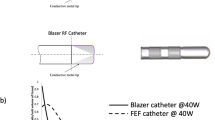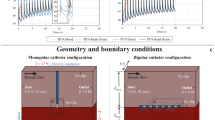Abstract
Microwave energy has been proposed as a possible technique to createlarge myocardial lesions. Achieving a uniform myocardial temperaturegradient during microwave ablation may prevent excessive endocardialtemperatures while maintaining temperatures at depth. The goal of thecurrent study was to examine the ability of microwave (MW) pulsing toachieve a more uniform myocardial temperature gradient. Using an in-vitroovine endocardial model, we measured tissue temperature at 0.5-mm, 2.0-mm,and 3.5-mm depths in a circulating saline bath. MW energy was delivered at20 W at 915 MHz for 30 seconds. Pulse configurations of 1 second on–1second off, 3 seconds on-3 seconds off, and 5 seconds on-5 seconds off, with30 seconds of total MW time were compared with 30-seconds continuous.Maximum temperatures at 0.5 mm were significantly lower at 63.2 ±5.89C for the 1-second pulse compared with 83.5 ∓ 7.31C for thecontinuous-energy delivery. Pulse configurations 3 seconds on–3seconds off and 5 seconds on–5 seconds off also resulted in asignificantly lower surface temperature than continuous-energy delivery.However, temperatures at the 2.0-mm and 3.5-mm depth created by the pulsingdelivery were similar to those achieved during continuous-energy delivery.Thus, microwave pulsing achieves a lower endocardial temperature and resultsin a more uniform temperature gradient. These techniques may prevent theexcessive endocardial damage that may result in an increased risk ofthrombus formation and embolization.
Similar content being viewed by others
References
Huang SKS, Lin JC, Mazzola F, Pires LA, Wagshal AB, Mittleman RS, Wang YJ, Percutaneous microwave ablation of the ventricular myocardium using a 4-mm split-tip antenna electrode: A novel method for potential ablation of ventricular tachycardia. J Am Coll Cardiol 1994;34A.
Pires LA, Huang SKS, Lin JC, Mazzola F, Wagshal AB, Cuenoud HF, Wang YJ. Comparison of radiofrequency ablation versus microwave energy catheter ablation of the bovine ventricular myocardium. PACE 1994;17:782.
Ruder M, Mead RH, Baron K, Radin M, Higgins S. Microwave ablation: In vivo data. PACE 1994;17:781.
Cohen TJ, Coggins D, Chin MC, Stauffer P, Scheinman MM, Langberg JJ. Microwave ablation of ventricular myocardium: The effects of varying duration on lesion volume. Circulation 1991;84:1711.
Yang X, Watanabe I, Kojima T, et al. Microwave ablation of the atrioventricular junction in vivo and ventricular myocardium in vitro and in vivo: Effects of varying power and duration on lesion volume. Jpn Heart J 1994;35:175–191.
Whayne JG, Nath S, Haines DE. Microwave catheter ablation of myocardium in vitro: Assessment of the characteristics of tissue heating and injury. Circulation 1994;89:2390–2395.
Wonnell TL, Stauffer PR, Langberg JJ. Evaluation of microwave and radiofrequency catheter ablation in a myocardium-equivalent phantom model. IEEE Trans Biomed Eng 1992;39:1086–1094.
Haines DE, Watson DD. Tissue heating during radiofrequency catheter ablation: A thermodynamic model and observations in isolated perfused and superfused canine right ventricular free wall. PACE 1989;12:962–976.
Wang PJ, Haugh C, Schoen FJ, et al. Left ventricular thrombus formation after high power microwave ablation: Implications for temperature and power regulation? Circulation 1993;88:I354.
Wang PJ, Ahmad A, Lenihan T, et al. Developing and testing a feedback control system for microwave ablation: In vitro and in vivo results. PACE 1994;17:782.
Sykes C, Riley M, Rowan R, Imran M. Cooled tip ablation results in increased radiofrequency power delivery and lesion size. PACE 1994;17:782.
Nibley C, Sykes CM, Chapman T, McLaughlin G, Rowan R, Wolf P, Wharton JM. Prevention of impedance rise during radiofrequency current catheter ablation by intra-electrode tip chilling. Circulation 1994;90:I271.
Author information
Authors and Affiliations
Rights and permissions
About this article
Cite this article
Haugh, C., Davidson, E.S., Estes III, N.M. et al. Pulsing Microwave Energy: A Method to Create More Uniform Myocardial Temperature Gradients. J Interv Card Electrophysiol 1, 57–65 (1997). https://doi.org/10.1023/A:1009770803013
Issue Date:
DOI: https://doi.org/10.1023/A:1009770803013




